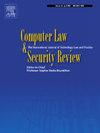Automated vehicles, the ‘driver dilemma’, stopping powers, and paradigms of regulating road traffic
IF 3.3
3区 社会学
Q1 LAW
引用次数: 0
Abstract
This article examines the driver dilemma as it applies to the increasing automation of road traffic with a focus on roadside enforcement stopping powers. The driver dilemma exists where road traffic laws are expressed as directed toward human drivers. As automation increases, it becomes more problematic who is the driver, in fact and in law, for the purposes of international and national road traffic laws. An obvious solution to the driver dilemma is to enact reforms that deem automated driving systems ‘drivers’ under road traffic laws. This can be seen in recent amendments to the Vienna Convention on Road Traffic. However, the deeming solution has limitations. Through a case study on specific Australian provisions that authorise roadside enforcement officers to stop vehicles, two paradigms informing regulation of road traffic are revealed. The legacy paradigm, founded on the unity of driver and vehicle, conceives road transport involving individuals with an expectation of freedom of movement. The deeming solution attempts to preserve this paradigm. The case study also revealed an alternative paradigm of road traffic as a system that should be regulated to ensure overarching public policy goals. This alternative paradigm is evident in the specific passenger transport laws, where stopping powers are expressed as vehicle-centric. There is no driver proxy and no need for a further wrong for the powers to be enlivened. The article concludes that automated transport futures need this alternative paradigm of road traffic regulation and vehicle-centric rules should be a template for more adaptable road traffic laws.
自动驾驶汽车、"驾驶员困境"、停车权和道路交通监管范式
本文以路边执法拦截权为重点,探讨了道路交通日益自动化所带来的驾驶员困境。驾驶员困境存在于道路交通法律针对人类驾驶员的情况下。随着自动化程度的提高,就国际和国内道路交通法律而言,在事实上和法律上谁是驾驶员变得越来越成问题。解决驾驶员困境的一个显而易见的办法是进行改革,将自动驾驶系统视为道路交通法中的 "驾驶员"。最近对《维也纳道路交通公约》的修订就体现了这一点。不过,视同解决方案也有局限性。通过对澳大利亚授权路边执法人员拦截车辆的具体规定进行案例研究,揭示了道路交通监管的两种范式。传统范式建立在驾驶员和车辆的统一性基础上,认为道路交通涉及到个人的行动自由。视同解决方案试图保留这一范式。案例研究还揭示了另一种范式,即道路交通是一个应受监管的系统,以确保实现公共政策的总体目标。这种另类范式在具体的客运法中很明显,在客运法中,拦截权以车辆为中心。没有驾驶员的代理,也不需要进一步的错误来激活权力。文章的结论是,未来的自动驾驶交通需要这种道路交通监管的替代范式,以车辆为中心的规则应成为适应性更强的道路交通法律的模板。
本文章由计算机程序翻译,如有差异,请以英文原文为准。
求助全文
约1分钟内获得全文
求助全文
来源期刊
CiteScore
5.60
自引率
10.30%
发文量
81
审稿时长
67 days
期刊介绍:
CLSR publishes refereed academic and practitioner papers on topics such as Web 2.0, IT security, Identity management, ID cards, RFID, interference with privacy, Internet law, telecoms regulation, online broadcasting, intellectual property, software law, e-commerce, outsourcing, data protection, EU policy, freedom of information, computer security and many other topics. In addition it provides a regular update on European Union developments, national news from more than 20 jurisdictions in both Europe and the Pacific Rim. It is looking for papers within the subject area that display good quality legal analysis and new lines of legal thought or policy development that go beyond mere description of the subject area, however accurate that may be.

 求助内容:
求助内容: 应助结果提醒方式:
应助结果提醒方式:


